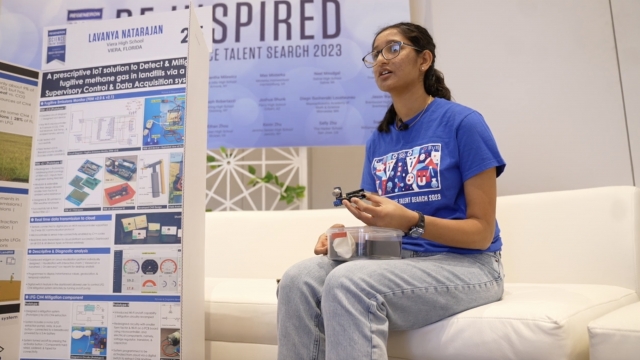The problems may seem enormous. The solutions to these challenges, though, are down-to-earth — and may be right here, among one group of bright students.
"It is the most prestigious high school research competition for seniors," said Maya Ajmera, president and CEO of the nonprofit Society for Science, which runs the longtime, annual Regeneron Science Talent Search.
"It was World War II and they were thinking, 'Who's the next generation of talent that's going to come up with new technologies, be the next engineers and scientists?'" Ajmera said. "And, so, they founded the Science Talent Search."
It starts with 2,000 science projects from across the country, which are narrowed down to 40. Those 40 students presented their detailed research to the competition's judges this week in Washington, D.C.
Among them is Angelina Fogarty, who invented a portable test that can determine if someone drugged a drink.
"Sexual assault causes psychological, physical and emotional distress," Fogarty said. "The way that I envisioned it being used is being able to test your drink if you're at a party or if you're at a bar and you want to test [whether] it's been contaminated with a date rape drug."
She showed us how it works: When a chemical is applied to a drink, the sensor changes color.
"That indicates to the user that the drink is unsafe," Fogarty said.
Ishika Nag developed spray-on, rechargeable nanoparticles as an inexpensive way of strengthening and extending the effectiveness of a mask.
"My project started when I realized how difficult it was for people living in heavily polluted areas to gain access to a filter that was both affordable and effective," she said.
Nag pointed out that 7 million people die from conditions stemming from poor air quality.
"They can afford to protect themselves against the dual problems of air pollution and virus pathogens," Nag said of her science project.
Lavanya Natarajan invented a device that can monitor and capture the methane emissions that come out of landfills.
"These are the three sensors I am using, so this is going to be the methane sensor," she said, while demonstrating how the device works.
Natarajan said those methane emissions from landfills can fuel climate change — but if captured, could be converted into energy.
SEE MORE: Chicago nonprofit is sparking kids' interest in STEM
"Once these fugitive methane emissions are being captured, then they can be harvested and then used for power in the future," Natarajan said.
Ariella Blackman's project was shooting for the stars.
"I'm an aspiring future astronaut," she said. "I want to go to Mars myself one day."
Her project focused on using simulated Mars dirt to grow food.
"I grew tepary beans, and I chose this because they grow in deserts in New Mexico and Arizona," Blackman said. "So they can grow well in really harsh environments with very little water."
Christina Chan with Regeneron said everyone in the competition shares something in common.
"I think unless you're really curious and you want to ask questions — and not just ask the questions, but try to find the answers and solutions — it's really hard to go through with as difficult of a competition as this can be," she said.
The competition awards more than $1 million in scholarships and prizes, but the students say just having made it this far in the competition means so much to them.
"This is just the cherry on top," Fogarty said.
For more information on the competition, the winners and the other science projects featured in it, click here.





